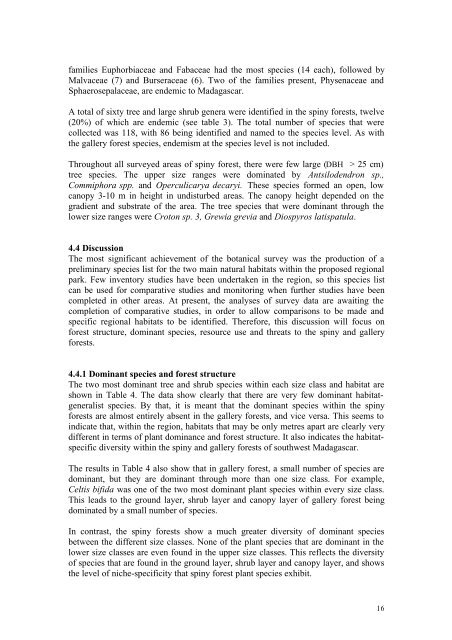The proposed Parc Regional de Belomotse - Frontier-publications ...
The proposed Parc Regional de Belomotse - Frontier-publications ...
The proposed Parc Regional de Belomotse - Frontier-publications ...
Create successful ePaper yourself
Turn your PDF publications into a flip-book with our unique Google optimized e-Paper software.
families Euphorbiaceae and Fabaceae had the most species (14 each), followed by<br />
Malvaceae (7) and Burseraceae (6). Two of the families present, Physenaceae and<br />
Sphaerosepalaceae, are en<strong>de</strong>mic to Madagascar.<br />
A total of sixty tree and large shrub genera were i<strong>de</strong>ntified in the spiny forests, twelve<br />
(20%) of which are en<strong>de</strong>mic (see table 3). <strong>The</strong> total number of species that were<br />
collected was 118, with 86 being i<strong>de</strong>ntified and named to the species level. As with<br />
the gallery forest species, en<strong>de</strong>mism at the species level is not inclu<strong>de</strong>d.<br />
Throughout all surveyed areas of spiny forest, there were few large (DBH > 25 cm)<br />
tree species. <strong>The</strong> upper size ranges were dominated by Antsilo<strong>de</strong>ndron sp.,<br />
Commiphora spp. and Operculicarya <strong>de</strong>caryi. <strong>The</strong>se species formed an open, low<br />
canopy 3-10 m in height in undisturbed areas. <strong>The</strong> canopy height <strong>de</strong>pen<strong>de</strong>d on the<br />
gradient and substrate of the area. <strong>The</strong> tree species that were dominant through the<br />
lower size ranges were Croton sp. 3, Grewia grevia and Diospyros latispatula.<br />
4.4 Discussion<br />
<strong>The</strong> most significant achievement of the botanical survey was the production of a<br />
preliminary species list for the two main natural habitats within the <strong>proposed</strong> regional<br />
park. Few inventory studies have been un<strong>de</strong>rtaken in the region, so this species list<br />
can be used for comparative studies and monitoring when further studies have been<br />
completed in other areas. At present, the analyses of survey data are awaiting the<br />
completion of comparative studies, in or<strong>de</strong>r to allow comparisons to be ma<strong>de</strong> and<br />
specific regional habitats to be i<strong>de</strong>ntified. <strong>The</strong>refore, this discussion will focus on<br />
forest structure, dominant species, resource use and threats to the spiny and gallery<br />
forests.<br />
4.4.1 Dominant species and forest structure<br />
<strong>The</strong> two most dominant tree and shrub species within each size class and habitat are<br />
shown in Table 4. <strong>The</strong> data show clearly that there are very few dominant habitatgeneralist<br />
species. By that, it is meant that the dominant species within the spiny<br />
forests are almost entirely absent in the gallery forests, and vice versa. This seems to<br />
indicate that, within the region, habitats that may be only metres apart are clearly very<br />
different in terms of plant dominance and forest structure. It also indicates the habitatspecific<br />
diversity within the spiny and gallery forests of southwest Madagascar.<br />
<strong>The</strong> results in Table 4 also show that in gallery forest, a small number of species are<br />
dominant, but they are dominant through more than one size class. For example,<br />
Celtis bifida was one of the two most dominant plant species within every size class.<br />
This leads to the ground layer, shrub layer and canopy layer of gallery forest being<br />
dominated by a small number of species.<br />
In contrast, the spiny forests show a much greater diversity of dominant species<br />
between the different size classes. None of the plant species that are dominant in the<br />
lower size classes are even found in the upper size classes. This reflects the diversity<br />
of species that are found in the ground layer, shrub layer and canopy layer, and shows<br />
the level of niche-specificity that spiny forest plant species exhibit.<br />
16
















